Technology finally caught up with the story. That’s a common phrase you hear these days. For example, it’s the basic line director Peyton Reed gives in the Ant-Man Blu-Ray special features to describe how Marvel was finally able to make a superhero who shrinks real small and controls ants look completely convincing instead of unintentionally funny. However, no project in recent history has better embodied the “technology finally caught up with the story” line than Jon Favreau’s The Jungle Book.
The story, in this case, has always been a very basic, episodic tale of a boy raised by wolves in the jungle of India where he befriends a lovable bear named Baloo. When Walt Disney got his hands on it in the mid-60s he turned it into, as Honest Trailers perfectly summed up, “A barely feature-length collection of random scenes tied together by a plot as thin as an orphan’s loan cloth as this young boy is passed from one joking, singing animal to another until a tiger finally shows up and probably burns to death.” Yeah, sure, but “Bare Necessities” is awfully catchy.
Huh. Maybe using the word “story” in relation to The Jungle Book is overstating things. Technology finally caught up with the basic premise then. In post-Avatar Hollywood, you can now make a movie about a young boy interacting with photo-realistic CGI animals who just happen to talk, and within a couple of minutes audiences will be completely sucked into that world, completely forgetting or perhaps blissfully oblivious to the fact that absolutely nothing they’re seeing on the screen other than the little boy is real:
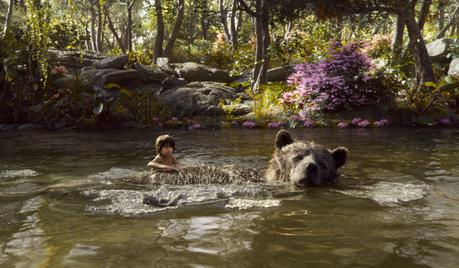
What we see
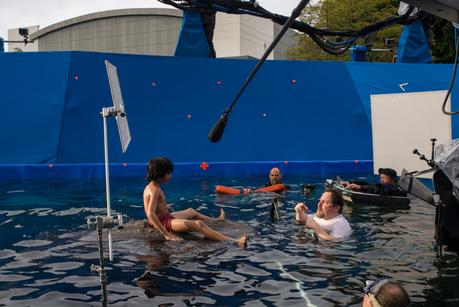
Versus how they made it
To refer to this new Jungle Book as the latest live-action remake of one of Disney’s animated classics is patently false because this new version is almost as entirely animated as the original. They just animated it all in a computer and surrounded a real life boy with pure visual effects. It’s the same “virtual production” technique utilized on Avatar and Gravity.
They had me fooled. I never once thought Neel Sethi, the 12-year-old New York City-born Indian-American who plays Mowgli, was getting so up close and personal with real wolves (part of a pack led by Lupita Nyong’o’s Raksha and Giancarlo Esposito’s Akela), hanging out with a bear (Bill Murray’s Baloo), being trained by a black panther (Ben Kingsley’s Bagheera), hypnotized by a giant snake (Scarlet Johansson’s Kaa), debating with a Gigantopithecus (Christopher Walken’s King Louie) or fleeing a tiger (Idris Elba’s Shere Khan). However, the environments and animals are all so astonishingly gorgeous and believable I assumed they must have filmed some of it practically, on location and/or with trained animals filmed on their own and then digitally spliced into footage with Sethi. Surely something like this shot of Bagheera perched atop a rock could be a real animal and background with maybe some digital alteration to his eyes and mouth:
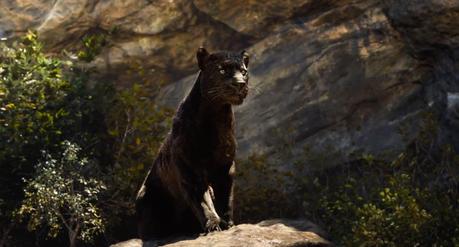
This is where we get into The Good Dinosaur/Avatar territory, though. The Good Dinosaur‘s breathtaking photo-realistic environments (not so much its curiously cartoony dinosaurs) make it Pixar’s most technologically impressive feature to date, and James Cameron and his team literally invented the technology necessary to make Avatar. However, all of that effort is wasted if it’s not done in service to a worthy story, and while The Good Dinosaur’s panoramic visuals are ground-breaking its story is remarkably simple and overly familiar. Avatar is rightfully derided as “Dances with Big Blue People” due to its many similarities to Dances with Wolves.
So while Disney gambled $175 million on this new Jungle Book, inspiring Rob Legato, a VFX Oscar winner for Avatar and Hugo, to call it “the most technically challenging film I have ever worked on, from every aspect,” did they remember to first start out with a good story?
They sure as heck tried. According to io9, Jon Favreau employed a Pixar/Disney Animation Studios hive mind approach to the project “by hiring a group of people to work on the story, and plotting out the film, in animatics and storyboards, dozens and dozens of times before even touching a camera.” Justin Marks may be the only credited screenwriter, but he’s far from being solely responsible for the story. As Favreau said, “You don’t always have this opportunity—to get Disney to commit to the resources to have a very robust pre-production. It allowed me make the storytelling mistakes before you ever start rolling.”
As such, The Jungle Book has a remarkably tight story structure which absolutely makes up for the many, many shortcomings of the story (or lack thereof) in Disney’s 1967 original. A mantra about the laws of the jungle which Mowgli learns at the beginning segues into a wonderful examination of the societal structure in the jungle (e.g., there is an understood truce in times of drought, elephants must be bowed to like royalty, man is forbidden, etc.), and it all comes back in a surprisingly poignant way at the end. Shere Khan’s exact beef with Mowgli is better explained, and the impact it has on his foster parents in the wolf pack is not overlooked. Mowgli is less an aimless brat and more a determined kid with his own sense of agency. Bagheera doesn’t repeatedly abandon Mowgli and abdicate his duties as surrogate father. Instead he is the stern mentor who cares quite deeply for the boy, and it is only due to understandable circumstances that he is not always around as protector. The new Scarlet Johansson version of Kaa is still a bit incidental but she does serve as the gateway to a crucial flashback sequence.
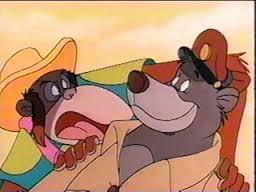
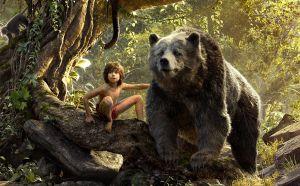
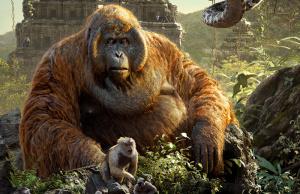
Maybe you didn’t watch Tail Spin. Maybe you just remember the songs. This new Jungle Book only has two of ’em, Baloo’s “Bare Necessities” and Louie’s “I Wan’na Be Like You,” and neither truly measures up to the originals despite Murray and Walken’s rather game efforts. Moreover, Favreau took differing approaches to both of them, presenting “Bare Necessities” as a more naturalistic ditty sung together by Baloo and Mowgli during a lazy swim down the river but making “I Wan’na Be Like You” a far more traditional “now we stop and sing” Disney musical number. As a result, the latter sticks out as feeling misplaced in the movie even though it’s a lot of fun. Scarlet Johansson does sing a new version of “Trust In Me,” but you’d never know it unless you sit through the closing credits.
THE BOTTOM LINE
The new Jungle Book is a technological triumph which is an improvement over the 1967 in just about every single way imaginable other than a couple of songs. What’s not to love? I left the theater thoroughly entertained, yet burdened with the gnawing sense that there still really isn’t a whole lot to the Jungle Book story. Jon Favreua and his team attempt to touch on themes of parental and communal responsibility, self-actualization and the delicate balance in nature between man and animal, making more of The Jungle Book than Walt Disney ever did, but this isn’t freakin’ Animal Farm we’re talking about here. This is still ultimately a story about a tiger who wants to kill a kid, and the various parts of the jungle which rise to either protect or threaten the boy as he runs for safety. Any metaphors you want to bring to it are entirely your own. When it looks this gorgeous, though, and is so capably performed by all involved that’s more than enough.
RottenTomatoes Consensus
95% – “As lovely to behold as it is engrossing to watch, The Jungle Book is the rare remake that actually improves upon its predecessors — all while setting a new standard for CGI.”
THE NOSTALGIA BUSTER
Have you re-watched the 1967 Jungle Book lately? Because I just did last night, and Honest Trailer’s nostalgia-busting parody trailer is spot-on:

